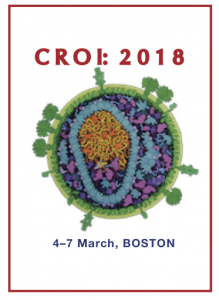Efavirenz 400 mg can be given with anti-tuberculosis treatment
14 March 2018. Related: Conference reports, TB coinfection.
 Polly Clayden, HIV i-Base
Polly Clayden, HIV i-Base
Isoniazid/rifampicin in HIV positive people without TB was associated with limited changes in efavirenz 400 mg exposure in a pharmacokinetic study presented at CROI 2018. Efavirenz concentrations were sufficient to maintain virological suppression.
WHO recommends efavirenz 400 mg (EFV400) as an alternative first-line antiretroviral with the caveat that there are no data on EFV400 with TB treatment. Many HIV positive people need TB treatment with isoniazid (INH) and rifampicin (RIF) that affect cytochrome P450 and antiretroviral exposure.
Maddalena Cerrone and colleagues from Chelsea and Westminster Hospital, London, Imperial College London, London and University of Liverpool performed an evaluation of EFV400 in the presence of INH and RIF in HIV positive people without TB.
This open-label study investigated the pharmacokinetics (PK), efficacy, CYP2B6 pharmacogenetics of EFV400 and INH/RIF in participants previously stable on tenofovir disoproxil fumarate (TDF), emtricitabine (FTC) and EFV 600 mg (EFV600) for at least 12 weeks with a viral load <50 copies/mL.
Stopping criteria was predefined as EFV concentrations below 20% of the minimum effective concentration (MEC) of 1000 ng/mL on three visits.
After switching from EFV600 to EFV400 alone, intensive PK was performed at day 14 (PK1), INH/RIF was then co-administered and intensive PK was repeated at day 42 (PK2) and day 92 (PK3).
The investigators also evaluated weekly therapeutic drug monitoring (TDM), safety, virological efficacy, and polymorphisms associated with increased steady state EFV exposure.
There were 34 participants screened and 26 baselined, 22 completed PK2 (3 participants withdrew for EFV400 TDM results <800 ng/mL in >3 consecutive visits, as per stopping rule, and 1 for of non-drug related liver toxicity). And 18 completed PK3 (2 withdrew for liver toxicity, 1 for low EFV levels and 1 became pregnant).
Participants were 64% male, a median of 47 years of age (range 22–60) and CD4 591 cells/mm3; 45% were black African and 18% slow metabolisers. All participants had viral load <50 at baseline, which was maintained throughout the study.
EFV Cmax, C24h and AUC0-24 were respectively 9%, 15% and 9% lower after four weeks of co-administration with INH/RIF (PK2) vs EFV400 alone (PK1). After another eight weeks (PK3) these respective values were 5%, 12% and 8% lower compared with PK2 and 16%, 25% and 16% lower compared with PK1. Table 1 shows PK parameters of EFV400 alone and co-administered with INH/RIF.
Table 1: PK EFV400 alone and with INH/RIF
| EFV GM (95% CI) | EFV GMR (90% CI) | |||||
| PK parameter | EFV400 (PK1) | EFV400 + INH/RIF day 42 (PK2) | EFV400 + INH/RIF day 98 (PK3) | PK2/PK1 | PK3/PK2 | PK3/PK1 |
| Cmax ng/mL CV% | 3257 (2554 to 4154)
83 |
2953
(2293 to 3804) 80 |
2791
(2020 to 3857) 87 |
0.91
(0.83 to 0.99) |
0.95
(0.86 to 1.05) |
0.84
(0.75 to 0.93) |
| C24h ng/mL CV% | 1703 (1180 to 2457)
124 |
1441 (948 to 2191)
128 |
1301
(790 to 2141) 133 |
0.85
(0.72 to 0.99) |
0.88
(0.75 to 1.03) |
0.75
(0.62 to 0.92) |
| AUC0-24 ng*h/mL CV% | 52259
(38284 to 71335) 107 |
47618
(33979 to 66732) 106 |
44004
(29442 to 65767) 113 |
0.91
(0.79 to 1.05) |
0.92
(0.83 to1.01) |
0.84
(0.72 to 0.99) |
Co-administration of EFV400 with INH/RIF was well-tolerated in 20/22 participants but resulted in >grade 3 ALT elevations in the remaining two. Two participants (extensive metabolisers) had low EFV levels and discontinued before receiving INH/RIF. Two more discontinued after two weeks on INH/RIF.
The plasma concentrations of EFV400 with INH/RIF were maintained above the cut-off extrapolated from the ENCORE1 study regardless of metaboliser status. All participants maintained viral load <50 copies/mL.
The investigators concluded that EFV400 can be co-administered with anti-TB treatment and this is being confirmed in people with HIV/TB coinfection.
comment
EFV is likely to remain an alternative first-line option even in the era of widespread dolutegravir (DTG) use – for reasons of tolerability, patents and price.
Using an EFV-based fixed-dose combination (FDC) during TB treatment could be a simpler option with programmatic advantages than adjusting the DTG dose.
The first FDC with EFV400 was tentatively approved by the FDA in March 2017.
References
- Cerrone M et al. Pharmacokinetics of efavirenz 400mg with isoniazid/rifampicin in people with HIV. 25th CROI. Boston. 4–7 March 2018.
Poster abstract 457.
www.croiconference.org/sites/default/files/posters-2018/1430_Cerrone_457.pdf (PDF) - FDA antiretrovirals approved and tentatively approved in association with the President’s Emergency Plan expedited review process. Number 193. 10 March 2017.
https://www.fda.gov/InternationalPrograms/PEPFAR/ucm119231.htm

